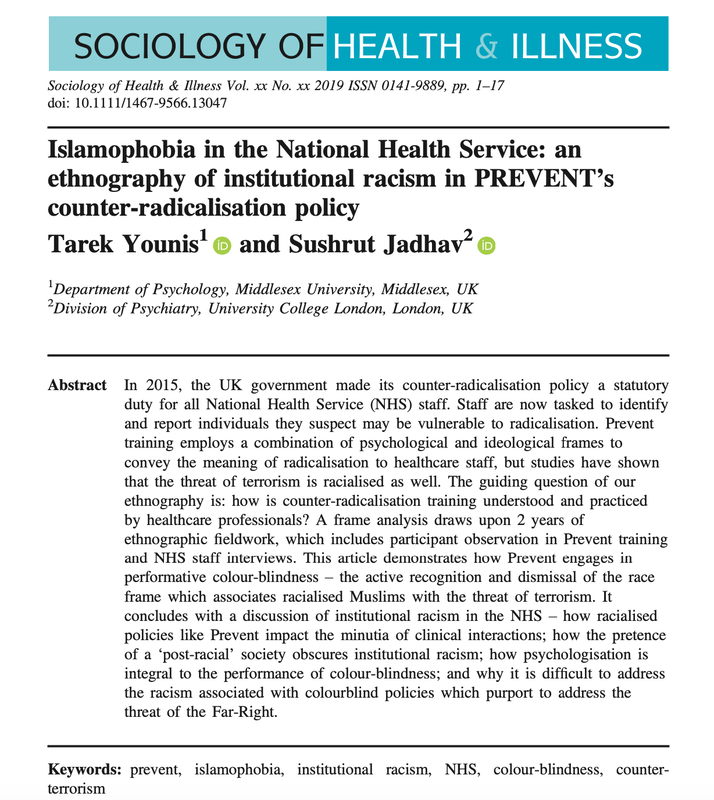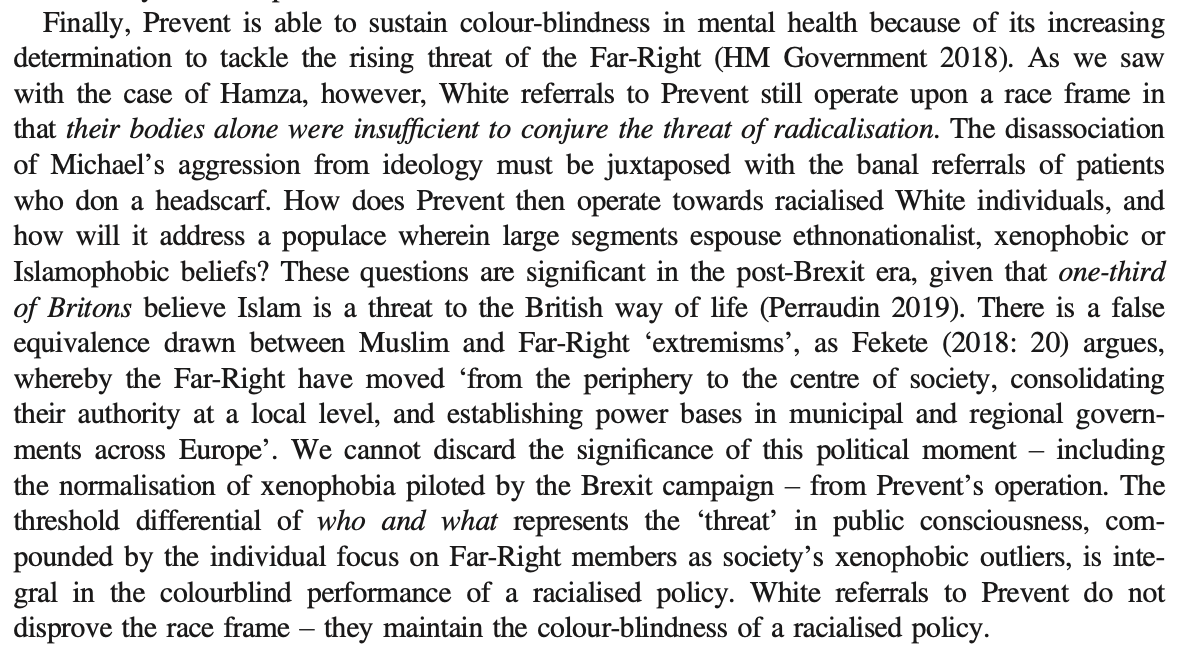This is empirical work which connects policy, Prevent training and actual Prevent referrals. The purpose is to operationalise Islamophobia as a systemic issue BEYOND overt verbal and physical abuse (hate crime). The key term I would like to bridge in to policies in the War on Terror, especially as we enter 2020, is colour-blindness. I explain how gov efforts to mitigate Islamophobia by pushing CVE towards ‘far-right’ or employing more Muslims doesn’t help—it makes things worse. The paper is unfortunately not open access but do let me know if you’d like to read it. This is a post summarising its content, and I explain its significance given the recent UK election results.
As we know, the Prevent duty was introduced in the NHS in 2011, not because there was evidence associating terrorism to health status, but because of a moral duty for everyone to ‘play their part’ in CT. Cast a wide net—see it, say it, sorted. Is there any clear criminological/diagnostic profile of radicalisation? No. So what are +1million NHS being trained in then? You’ll find training is very broad and elusive—a generic collection of ‘risk factors’ (low self-esteem, need for identity, etc). The purpose here, understated but very clear, is to have staff act upon ‘gut feelings’—better safe than sorry. Here I always mention that no other social ill has such an evidence-less moral duty. Consider that between 2013 and 2016 there have been over 300 domestic homicies in the UK. Is there a dedicated training program to report these (largely white male) pre-criminals vulnerable to future violence? There isn’t.
The insistence on gut feeling is KEY to understanding how racial prejudice is legitimised through policy—institutional racism. What are gut feelings based upon? We see NHS is not an apolitical space; NHS staff generally reflect the public’s popular imagination. Who is most associated with threat in UK imaginary? Muslims. At this point, I don’t even have to qualify this statement, but in case you need more evidence, here’s one of many surveys (much more than this obviously). So racialised Muslims (as in, ppl who look/act “Muslim”) embody ‘threat’ in public imagination, and a policy comes along and says ‘refer potential pre-threats’.
Everyone knows the rest—I’m not going to repeat what others have said about Prevent: the chilling effect, depoliticisaiton, racist referrals etc. What’s more important to me is what Prevent reveals how race and racism operate in healthcare setting. I give an example of a GP who immediately thought of Prevent when a Muslim male said he wanted to homeschool his children. She then withheld asking further questions. This small, invisible but racialised interaction explains how little gov Prevent statistics captures in terms of impact. Would the GP have thought of Prevent if the patient was a white, middle-class woman wanting to homeschool her child? No. No referral happened, nothing changed visibly—yet the clinical interaction changed irreversibly because of the Prevent duty.
Again, as I explained before, this is the failure of government statistics to capture impact of Prevent duty, which potentially has impacted the minutia of clinical interactions with EVERY patient—beyond referral statistics. Muslims are associated with threat in British public imagination. The gov knows this. What do they do? In training, we see what I call ‘performative colorblindness’: the active erasure of this commonsensical association between Muslims and threat. They do this in two ways.
First, they tell people to NOT associate Muslims/Islam with radicalisation. “Is it a Muslim wearing a hijab? No. Is it the beard? No. [Note: I’ve attended police training where they said yes to beard]” What they’re doing is raising a signifier (beard) then erasing it. This raising/erasing is endless. Prevent assumes it’s addressing prejudice by doing so, but in reality, performative colorblindness only substantiates the reality that the public DOES associate threat with Muslims. Is it an effective pedagogical strategy to just train people not to be racist? No—obviously not. This is very important: Anti-racism is NOT the purpose of colorblindness. Rather as Michelle Alexander explains very well, the purpose of colour-blindness is to clear the policy maker from the charge of racism. They can now say that any racist referral is the problem of the individual, not the policy
Second, psychologisation is key, using a universalist language of ‘vulnerability’. Just as anyone is susceptible to mental illness, so too is everyone susceptible to radicalisation based on our shared human framework. What else is the gov doing then to address the racism of the Prevent policy then? The following are key points which each need to be deconstructed individually: 1) Employing more Muslims in CVE/Prevent and 2) Pushing ‘harder’ towards the Far-Right and
As for 1), my answer to this has always been the same: Obama. We know very well by now that representation is hardly the solution to prejudice. Worse, it makes it even more difficult for the public to understand how racism operates through policies. As for 2), The Far-Right, the problem with this is obvious if you’ve followed everything I’ve written until now. See pic attached. Simply put: “White referrals to Prevent still operate upon a race frame in that their bodies alone are insufficient to conjure the threat of radicalisation”.
As for a possible alternative, the Transnational Institute recently provided a very good, comprehensive evidence-based framework for political violence--a progressive alternative to the counter-terrorism strategy the UK currently has, including Prevent. I’ve yet to see an official respond to this. But of course, if you want my opinion: history has no control groups, but what evidence is there, for example, that NHS staff are not perfectly capable of reporting individuals who pose a threat (to themselves/others) to police, as they always have? This would have saved the NHS a ridiculous amount of time and money from evidence-deficient Prevent training.
Prevent cannot only be judged by its stated objectives. I always give the example of the mayor who poisons a city’s water to kill a few rats. Sure, he might catch the rats—but everyone in the city is sick. In this case, those who are sick have very little political clout in the British imagination. Here Prevent will draw on good will, shrouded evidence (‘we’ve helped 300 people!’) and dubious labels (‘we stopped an extremist!’). But what if the system was good enough already, and this politics-based, racist policy is making things worse, revealing how prejudicial judgements can be made without fear?
Take the issue with accountability for example: what if a staff member acts upon racial prejudice and refer a bearded Muslim? What then? Nothing. The referral may be rejected, but this person goes back to work, like it was just another, totally normal occurrence. Without clarity or transparency of what interventions or success looks like (I mean all cases, not just the ones they allow us to see), Prevent doesn’t allow civil society to creatively and constructively address pol. violence on our own terms. If success e.g. is giving a Muslim adolescent mental health services under coercion, then I have something to say about that
Maybe until then we should trust staff to just do their jobs, not descend upon them with more policies to direct and manage their behaviour, especially as it relates to such a low-probability events as terrorism. I trust staff far less with a duty to act upon their ‘gut feelings to detect and report threat’. The proof in the pudding is the current elections: we see very clearly how Islamophobia has zero political clout in the British public’s decision-making. People simply have acquiesced to the ‘Other-ing’ of Muslims, and Islamophobia has been all the while contested, mocked and disregarded.
Any racialised policy which affects Muslims in THIS political climate will never inspire moral panic. People, like Boris Johnson, will simply continue their day-job believing ‘Islam is the problem’. And there are many people like Boris Johnson—hence the election results. Is that not reason enough to withdraw the Prevent duty and immediately consider alternatives? I guess not.


 RSS Feed
RSS Feed